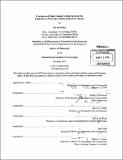Evaluation of multi-vehicle architectures for the exploration of planetary bodies in the Solar System
Author(s)
Alibay, Farah
DownloadFull printable version (29.60Mb)
Other Contributors
Massachusetts Institute of Technology. Department of Aeronautics and Astronautics.
Advisor
Jeffrey A. Hoffman.
Terms of use
Metadata
Show full item recordAbstract
Planetary exploration missions are becoming increasingly complex and expensive due to ever more ambitious scientific and technical goals. On the other hand, budgets in planetary science have suffered from dramatic cuts over the past decade and projections estimate a flat budget of approximately $1.2B/year for the upcoming years. This has led to a desire for a reduction in the risk and complexity, as well as an increase in the robustness and reliability, of planetary exploration vehicles. One of the methods proposed to deal with this issue is the use of distributed, multi-vehicle architectures as a replacement for the traditional large, monolithic systems used in flagship missions. However, mission concept formulation engineers do not possess the tools to include multi-vehicle architectures in their early trade space exploration process. This is mostly due to the fact that these types of architectures cannot be readily evaluated against monolithic systems through the use of traditional mass-based metrics. Furthermore, in multi-vehicle system, architectural decisions about one vehicle, such as instrument or capability selection, quickly propagate through the entire system and impose requirements on the other vehicles. This can be difficult to model without going through detailed point designs. The objective of this thesis is to explore the potential benefits of both spatially and temporally distributed multi-vehicle systems, where the vehicles are heterogeneous, as compared to monolithic systems. Specifically, a set of metrics mapping the effects of using multi-vehicle systems on science benefit, complexity, mass, cost, coverage, productivity and risk are developed. Furthermore, a software tool to simulate the performance of teams of planetary surface vehicles in their operational environment has been built and its use demonstrated. Finally, the framework put forward in this thesis is used to perform several case studies, including a case study on the exploration of the Jovian moon Europa and another on the ascent and return components of a Mars Sample Return mission. From these, distributed systems are shown to provide increased science return and robustness as well as lower development and manufacturing costs as compared to their monolithic equivalents.
Description
Thesis: Ph. D., Massachusetts Institute of Technology, Department of Aeronautics and Astronautics, 2014. Cataloged from PDF version of thesis. Includes bibliographical references (pages 193-210).
Date issued
2014Department
Massachusetts Institute of Technology. Department of Aeronautics and AstronauticsPublisher
Massachusetts Institute of Technology
Keywords
Aeronautics and Astronautics.